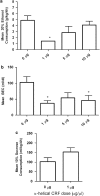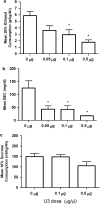CRF-1 antagonist and CRF-2 agonist decrease binge-like ethanol drinking in C57BL/6J mice independent of the HPA axis
- PMID: 20130533
- PMCID: PMC2927867
- DOI: 10.1038/npp.2009.209
CRF-1 antagonist and CRF-2 agonist decrease binge-like ethanol drinking in C57BL/6J mice independent of the HPA axis
Abstract
Recent evidence suggests that corticotropin-releasing factor (CRF) receptor (CRFR) signaling is involved in modulating binge-like ethanol consumption in C57BL/6J mice. In this report, a series of experiments were performed to further characterize the role of CRFR signaling in binge-like ethanol consumption. The role of central CRFR signaling was assessed with intracerebroventricular (i.c.v.) infusion of the nonselective CRFR antagonist, alpha-helical CRF(9-41) (0, 1, 5, 10 microg/1 microl). The contribution of central CRF type 2 receptor (CRF(2)R) signaling was assessed with i.c.v. infusion of the selective CRF(2)R agonist, urocortin (Ucn) 3 (0, 0.05, 0.1, or 0.5 microg/1 microl). The role of the hypothalamic-pituitary-adrenal (HPA) axis was assessed by pretreating mice with intraperitoneal (i.p.) injection of (1) the corticosterone synthesis inhibitor, metyrapone (0, 50, 100, 150 mg/kg) or (2) the glucocorticoid receptor antagonist, mifepristone (0, 25, 50 mg/kg), and (3) by using radioimmunoassay to determine whether binge-like ethanol intake influenced plasma corticosterone levels. Finally, we determined whether the ability of the CRF(1)R antagonist, CP-154,526 (CP; 0, 10, 15 mg/kg, i.p.), to blunt binge-like drinking required normal HPA axis signaling by comparing the effectiveness of CP in adrenalectomized (ADX) and normal mice. Results showed that i.c.v. infusion of a 1 microg dose of alpha-helical CRF(9-41) significantly attenuated binge-like ethanol consumption relative to vehicle treatment, and i.c.v. infusion of Ucn 3 dose-dependently blunted binge-like drinking. On the other hand, metyrapone nonselectively reduced both ethanol and sucrose consumption, mifepristone did not alter ethanol drinking, and binge-like drinking did not correlate with plasma corticosterone levels. Finally, i.p. injection of CP significantly attenuated binge-like ethanol intake in both ADX and normal mice. Together, these results suggest that binge-like ethanol intake in C57BL/6J mice is modulated by CRF(1)R and CRF(2)R signaling, such that blockade of CRF(1)R or activation of CRF(2)R effectively reduces excessive ethanol intake. Furthermore, normal HPA axis signaling is not necessary to achieve binge-like drinking behavior.
Figures




Similar articles
-
Blockade of the corticotropin releasing factor type 1 receptor attenuates elevated ethanol drinking associated with drinking in the dark procedures.Alcohol Clin Exp Res. 2008 Feb;32(2):259-65. doi: 10.1111/j.1530-0277.2007.00575.x. Epub 2007 Dec 21. Alcohol Clin Exp Res. 2008. PMID: 18162072 Free PMC article.
-
Pre-clinical evidence that corticotropin-releasing factor (CRF) receptor antagonists are promising targets for pharmacological treatment of alcoholism.CNS Neurol Disord Drug Targets. 2010 Mar;9(1):77-86. doi: 10.2174/187152710790966605. CNS Neurol Disord Drug Targets. 2010. PMID: 20201818 Free PMC article. Review.
-
Extended Amygdala to Ventral Tegmental Area Corticotropin-Releasing Factor Circuit Controls Binge Ethanol Intake.Biol Psychiatry. 2017 Jun 1;81(11):930-940. doi: 10.1016/j.biopsych.2016.02.029. Epub 2016 Mar 3. Biol Psychiatry. 2017. PMID: 27113502 Free PMC article.
-
The hypothalamopituitary-adrenal axis and alcohol preference.Brain Res Bull. 2005 Dec 30;68(3):171-8. doi: 10.1016/j.brainresbull.2005.08.006. Epub 2005 Sep 8. Brain Res Bull. 2005. PMID: 16325017
-
Don't stress about CRF: assessing the translational failures of CRF1antagonists.Psychopharmacology (Berl). 2017 May;234(9-10):1467-1481. doi: 10.1007/s00213-017-4556-2. Epub 2017 Mar 7. Psychopharmacology (Berl). 2017. PMID: 28265716 Free PMC article. Review.
Cited by
-
Rodent models and mechanisms of voluntary binge-like ethanol consumption: Examples, opportunities, and strategies for preclinical research.Prog Neuropsychopharmacol Biol Psychiatry. 2016 Feb 4;65:297-308. doi: 10.1016/j.pnpbp.2015.05.012. Epub 2015 Jun 2. Prog Neuropsychopharmacol Biol Psychiatry. 2016. PMID: 26021391 Free PMC article. Review.
-
Preclinical development of moxidectin as a novel therapeutic for alcohol use disorder.Neuropharmacology. 2017 Feb;113(Pt A):60-70. doi: 10.1016/j.neuropharm.2016.09.016. Epub 2016 Sep 15. Neuropharmacology. 2017. PMID: 27641072 Free PMC article.
-
Serotonergic Neuroplasticity in Alcohol Addiction.Brain Plast. 2016 Jun 29;1(2):177-206. doi: 10.3233/BPL-150022. Brain Plast. 2016. PMID: 29765841 Free PMC article. Review.
-
Preclinical evidence implicating corticotropin-releasing factor signaling in ethanol consumption and neuroadaptation.Genes Brain Behav. 2015 Jan;14(1):98-135. doi: 10.1111/gbb.12189. Genes Brain Behav. 2015. PMID: 25565358 Free PMC article. Review.
-
Chronic alcohol neuroadaptation and stress contribute to susceptibility for alcohol craving and relapse.Pharmacol Ther. 2011 Feb;129(2):149-71. doi: 10.1016/j.pharmthera.2010.09.007. Epub 2010 Oct 15. Pharmacol Ther. 2011. PMID: 20951730 Free PMC article. Review.
References
-
- Arborelius L, Owens MJ, Plotsky PM, Nemeroff CB. The role of corticotropin-releasing factor in depression and anxiety disorders. J Endocrinol. 1999;160:1–12. - PubMed
-
- Battaglia G, Webster EL, De Souza EB. Characterization of corticotropin-releasing factor receptor-mediated adenylate cyclase activity in the rat central nervous system. Synapse. 1987;1:572–581. - PubMed
-
- Bonomo YA, Bowes G, Coffey C, Carlin JB, Patton GC. Teenage drinking and the onset of alcohol dependence: a cohort study over seven years. Addiction (Abingdon, England) 2004;99:1520–1528. - PubMed
-
- Brauns O, Liepold T, Radulovic J, Spiess J. Pharmacological and chemical properties of astressin, antisauvagine-30 and alpha-helCRF: significance for behavioral experiments. Neuropharmacology. 2001;41:507–516. - PubMed
-
- Centers for Disease Control and Prevention (CDC) Sociodemographic differences in binge drinking among adults—14 States, 2004. MMWR Surveill Summ. 2009;58:301–304. - PubMed
Publication types
MeSH terms
Substances
Grants and funding
- R01 AA016629/AA/NIAAA NIH HHS/United States
- F31 AA017803/AA/NIAAA NIH HHS/United States
- P60 AA011605/AA/NIAAA NIH HHS/United States
- AA016629/AA/NIAAA NIH HHS/United States
- R37 AA013573/AA/NIAAA NIH HHS/United States
- P50 AA011605/AA/NIAAA NIH HHS/United States
- AA017803/AA/NIAAA NIH HHS/United States
- R01 AA014983/AA/NIAAA NIH HHS/United States
- R37 AA014983/AA/NIAAA NIH HHS/United States
- R01 AA015148/AA/NIAAA NIH HHS/United States
- AA015148/AA/NIAAA NIH HHS/United States
- A1AA013573/AA/NIAAA NIH HHS/United States
- AA014983/AA/NIAAA NIH HHS/United States
- AA011605/AA/NIAAA NIH HHS/United States
- R01 AA013573/AA/NIAAA NIH HHS/United States
LinkOut - more resources
Full Text Sources
Other Literature Sources
Miscellaneous

